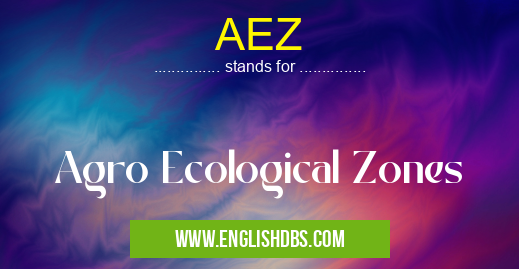What does AEZ mean in UNCLASSIFIED
AEZ stands for Agro Ecological Zones. It is a system of classifying land areas based on their climate, soil, and vegetation characteristics. AEZs are used to identify areas with similar agricultural potential and to develop appropriate land-use plans.

AEZ meaning in Unclassified in Miscellaneous
AEZ mostly used in an acronym Unclassified in Category Miscellaneous that means Agro Ecological Zones
Shorthand: AEZ,
Full Form: Agro Ecological Zones
For more information of "Agro Ecological Zones", see the section below.
Key Characteristics of AEZs
- Climate: AEZs are defined based on factors such as temperature, rainfall, and humidity.
- Soil: Soil characteristics, including texture, depth, and fertility, play a role in determining the suitability of land for different types of agriculture.
- Vegetation: The type of vegetation present in an area provides an indication of the soil and climate conditions.
Benefits of Using AEZs
- Agricultural Planning: AEZs help in planning agricultural activities by identifying areas suitable for specific crops and livestock.
- Land-Use Management: They provide a basis for developing land-use policies that promote sustainable agriculture.
- Environmental Conservation: AEZs can be used to identify areas of high conservation value and develop strategies for protecting them.
Types of AEZs
There are various types of AEZs, each with its own unique characteristics:
- Tropical AEZs: Characterized by warm temperatures, high rainfall, and lush vegetation.
- Temperate AEZs: Experience moderate temperatures and rainfall, with distinct seasons.
- Arid and Semi-Arid AEZs: Receive low rainfall and have sparse vegetation.
Essential Questions and Answers on Agro Ecological Zones in "MISCELLANEOUS»UNFILED"
What are Agro Ecological Zones (AEZs)?
Agro Ecological Zones are areas with similar climate, soil, and landforms, which determine their potential for agricultural production. They provide a framework for planning agricultural development and land use.
What are the different types of AEZs?
AEZs can be classified based on various factors, such as rainfall, temperature, soil type, and altitude. Some common classifications include:
- Highlands: Characterized by high altitudes, low temperatures, and higher rainfall.
- Midlands: Located between highlands and lowlands, with moderate temperatures and rainfall.
- Lowlands: Have low altitudes, high temperatures, and often less rainfall.
How are AEZs used in agriculture?
AEZs guide agricultural planning and decision-making by:
- Identifying suitable crops and livestock for different regions.
- Determining optimal farming practices and technologies.
- Assessing land potential and constraints for agricultural production.
- Monitoring agricultural productivity and sustainability.
What is the importance of considering AEZs in agricultural development?
Considering AEZs is crucial because it allows for:
- Matching agricultural practices to the specific characteristics of each zone.
- Optimizing resource allocation and avoiding inappropriate land use.
- Minimizing the risk of crop failures and environmental degradation.
- Promoting sustainable agricultural practices tailored to local conditions.
How are AEZs identified and mapped?
AEZs are identified and mapped using a combination of:
- Climate data (e.g., rainfall, temperature, humidity)
- Soil surveys
- Landform analysis
- Remote sensing and GIS technologies
- Field observations and local knowledge.
Final Words: AEZs are a valuable tool for agricultural planning and land-use management. By understanding the characteristics of different AEZs, decision-makers can make informed choices about land use and agricultural practices. This system helps ensure the sustainable use of land resources and the development of resilient agricultural systems.
AEZ also stands for: |
|
| All stands for AEZ |
